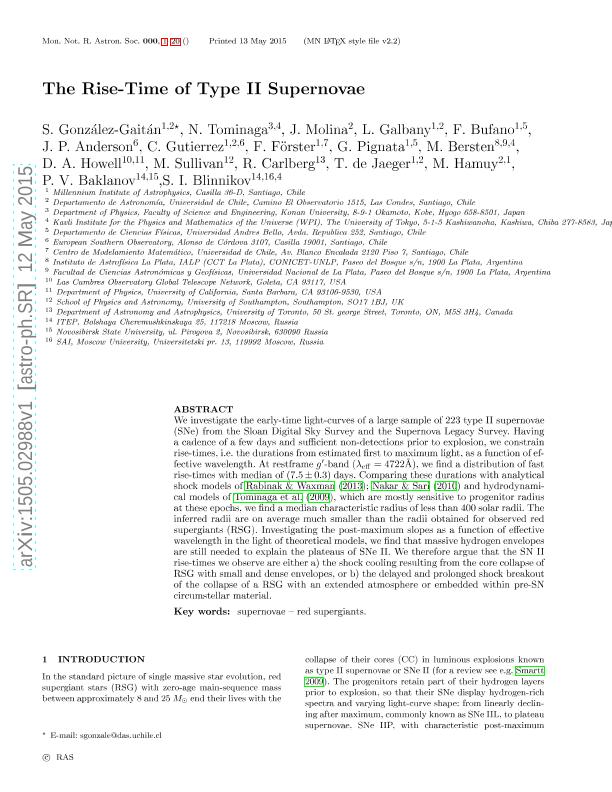Mostrar el registro sencillo del ítem
dc.contributor.author
González Gaitán, S.
dc.contributor.author
Tominaga, N.
dc.contributor.author
Molina, J.
dc.contributor.author
Galbany, L.
dc.contributor.author
Bufano, F.
dc.contributor.author
Anderson, J. P.
dc.contributor.author
Gutierrez, C.
dc.contributor.author
Förster, F.
dc.contributor.author
Pignata, G.
dc.contributor.author
Bersten, Melina Cecilia

dc.contributor.author
Howell, D. A.
dc.contributor.author
Sullivan, M.
dc.contributor.author
Carlberg, R.
dc.contributor.author
De Jaeger, T.
dc.contributor.author
Hamuy, M.
dc.contributor.author
Baklanov, P. V.
dc.contributor.author
Blinnikov, S. I.
dc.date.available
2017-03-13T19:08:26Z
dc.date.issued
2015-05
dc.identifier.citation
González Gaitán, S.; Tominaga, N.; Molina, J.; Galbany, L.; Bufano, F.; et al.; The rise-time of type II supernovae; Oxford University Press; Monthly Notices Of The Royal Astronomical Society; 451; 2; 5-2015; 2212-2229
dc.identifier.issn
0035-8711
dc.identifier.uri
http://hdl.handle.net/11336/13779
dc.description.abstract
We investigate the early-time light-curves of a large sample of 223 type II supernovae (SNe) from the Sloan Digital Sky Survey and the Supernova Legacy Survey. Having a cadence of a few days and sufficient non-detections prior to explosion, we constrain rise-times, i.e. the durations from estimated first to maximum light, as a function of effective wavelength. At restframe g-band (4722A), we find a distribution of fast rise-times with median of (7.5+/-0.3) days. Comparing these durations with analytical shock models of Rabinak and Waxman (2013); Nakar and Sari (2010) and hydrodynamical models of Tominaga et al. (2009), which are mostly sensitive to progenitor radius at these epochs, we find a median characteristic radius of less than 400 solar radii. The inferred radii are on average much smaller than the radii obtained for observed red supergiants (RSG). Investigating the post-maximum slopes as a function of effective wavelength in the light of theoretical models, we find that massive hydrogen envelopes are still needed to explain the plateaus of SNe II. We therefore argue that the SN II rise-times we observe are either a) the shock cooling resulting from the core collapse of RSG with small and dense envelopes, or b) the delayed and prolonged shock breakout of the collapse of a RSG with an extended atmosphere or embedded within pre-SN circumstellar material.
dc.format
application/pdf
dc.language.iso
eng
dc.publisher
Oxford University Press

dc.rights
info:eu-repo/semantics/openAccess
dc.rights.uri
https://creativecommons.org/licenses/by-nc-sa/2.5/ar/
dc.subject
Supernovae
dc.subject
Red Supergiants
dc.subject.classification
Astronomía

dc.subject.classification
Ciencias Físicas

dc.subject.classification
CIENCIAS NATURALES Y EXACTAS

dc.title
The rise-time of type II supernovae
dc.type
info:eu-repo/semantics/article
dc.type
info:ar-repo/semantics/artículo
dc.type
info:eu-repo/semantics/publishedVersion
dc.date.updated
2017-03-07T15:21:31Z
dc.journal.volume
451
dc.journal.number
2
dc.journal.pagination
2212-2229
dc.journal.pais
Reino Unido

dc.journal.ciudad
Londres
dc.description.fil
Fil: González Gaitán, S.. Universidad de Chile; Chile. Millennium Institute of Astrophysics; Chile
dc.description.fil
Fil: Tominaga, N.. Konan University; Japón
dc.description.fil
Fil: Molina, J.. Universidad de Chile; Chile
dc.description.fil
Fil: Galbany, L.. Universidad de Chile; Chile. Millennium Institute of Astrophysics; Chile
dc.description.fil
Fil: Bufano, F.. Universidad Andres Bello; Chile. Millennium Institute of Astrophysics; Chile
dc.description.fil
Fil: Anderson, J. P. . European Southern Observatory; Chile
dc.description.fil
Fil: Gutierrez, C.. Universidad de Chile; Chile. Millennium Institute of Astrophysics; Chile
dc.description.fil
Fil: Förster, F.. Millennium Institute of Astrophysics; Chile. Universidad de Chile; Chile
dc.description.fil
Fil: Pignata, G.. Universidad Andres Bello; Chile. Millennium Institute of Astrophysics; Chile
dc.description.fil
Fil: Bersten, Melina Cecilia. Consejo Nacional de Investigaciones Científicas y Técnicas. Centro Científico Tecnológico La Plata. Instituto de Astrofísica de La Plata; Argentina. Universidad Nacional de la Plata. Facultad de Ciencias Astronómicas y Geofísicas; Argentina. University of Tokyo; Japón
dc.description.fil
Fil: Howell, D. A. . Las Cumbres Observatory Global Telescope Network; Estados Unidos. University of California; Estados Unidos
dc.description.fil
Fil: Sullivan, M.. University of Southampton; Reino Unido
dc.description.fil
Fil: Carlberg, R.. University Of Toronto; Canadá
dc.description.fil
Fil: De Jaeger, T. . Universidad de Chile; Chile. Millennium Institute of Astrophysics; Chile
dc.description.fil
Fil: Hamuy, M.. Universidad de Chile; Chile. Millennium Institute of Astrophysics; Chile
dc.description.fil
Fil: Baklanov, P. V. . Novosibirsk State University; Rusia
dc.description.fil
Fil: Blinnikov, S. I. . University of Tokyo; Japón
dc.journal.title
Monthly Notices Of The Royal Astronomical Society

dc.relation.alternativeid
info:eu-repo/semantics/altIdentifier/url/https://academic.oup.com/mnras/article-abstract/451/2/2212/1749558/The-rise-time-of-Type-II-supernovae?redirectedFrom=fulltext
dc.relation.alternativeid
info:eu-repo/semantics/altIdentifier/arxiv/https://doi.org/10.1093/mnras/stv1097
Archivos asociados
